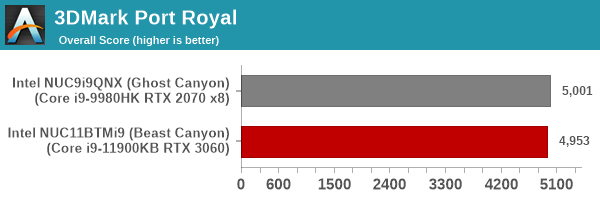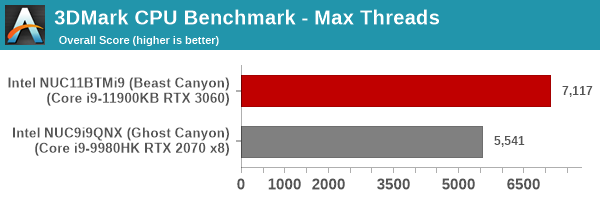Intel Beast Canyon NUC Review: Desktop Tiger Lake Debuts in SFF Gaming Powerhouse
by Ganesh T S on July 29, 2021 9:00 AM EST- Posted in
- Systems
- Intel
- NUC
- Tiger Lake
- NUC11
- Beast Canyon
UL Benchmarks - PCMark and 3DMark
This section deals with a couple of UL Futuremark benchmarks - PCMark 10 and 3DMark. While PCMark evaluates the system as a whole, 3DMark focuses on the graphics capabilities with emphasis on gaming workloads.
PCMark 10
UL's PCMark 10 evaluates computing systems for various usage scenarios (generic / essential tasks such as web browsing and starting up applications, productivity tasks such as editing spreadsheets and documents, gaming, and digital content creation). We benchmarked select PCs with the PCMark 10 Extended profile and recorded the scores for various scenarios. These scores are heavily influenced by the CPU and GPU in the system, though the RAM and storage device also play a part. The power plan was set to Balanced for all the PCs while processing the PCMark 10 benchmark.





3DMark
UL's 3DMark comes with a diverse set of graphics workloads that target different Direct3D feature levels. Correspondingly, the rendering resolutions are also different. We use 3DMark 2.4.4264 to get an idea of the graphics capabilities of the system. In this section, we take a look at the performance of the Intel NUC11BTMi9 (Beast Canyon) across the different 3DMark workloads.
3DMark Ice Storm
This workload has three levels of varying complexity - the vanilla Ice Storm, Ice Storm Unlimited, and Ice Storm Extreme. It is a cross-platform benchmark (which means that the scores can be compared across different tablets and smartphones as well). All three use DirectX 11 (feature level 9) / OpenGL ES 2.0. While the Extreme renders at 1920 x 1080, the other two render at 1280 x 720. The graphs below present the various Ice Storm worloads' numbers for different systems that we have evaluated.
| UL 3DMark - Ice Storm Workloads | |||

3DMark Cloud Gate
The Cloud Gate workload is meant for notebooks and typical home PCs, and uses DirectX 11 (feature level 10) to render frames at 1280 x 720. The graph below presents the overall score for the workload across all the systems that are being compared.

3DMark Fire Strike
The Fire Strike benchmark has three workloads. The base version is meant for high-performance gaming PCs. Similar to Sky Diver, it uses DirectX 11 (feature level 11) to render frames at 1920 x 1080. The Extreme version targets 1440p gaming requirements, while the Ultra version targets 4K gaming system, and renders at 3840 x 2160. The graph below presents the overall score for the Fire Strike Extreme and Fire Strike Ultra benchmark across all the systems that are being compared.
| UL 3DMark - Fire Strike Workloads | |||

3DMark Time Spy
The Time Spy workload has two levels with different complexities. Both use DirectX 12 (feature level 11). However, the plain version targets high-performance gaming PCs with a 2560 x 1440 render resolution, while the Extreme version renders at 3840 x 2160 resolution. The graphs below present both numbers for all the systems that are being compared in this review.
| UL 3DMark - Time Spy Workloads | |||

3DMark Night Raid
The Night Raid workload is a DirectX 12 benchmark test. It is less demanding than Time Spy, and is optimized for integrated graphics. The graph below presents the overall score in this workload for different system configurations.

3DMark Port Royal
UL introduced the Port Royal ray-tracing benchmark as a DLC for 3DMark in early 2019. The scores serve as an indicator of how the system handles ray-tracing effects in real-time.

3DMark CPU Profile Benchmark
UL recently introduced a benchmark to test the multi-threaded capabilities of the CPU in a system. Since gaming workloads are often multi-threaded, it makes sense to include this testing as part of the 3DMark suite. The benchmark routine attempts to perform the simulation of birds / bird-like objects flocking together using as many advanced capabilities as offered by the processor. The workload is configured to run with different number of threads ranging from 1 to 16 (and a single entry for the maximum number of threads allowed in the system).
| UL 3DMark - CPU Profile Benchmark | |||

We present the benchmark results for the single and maximum threads case above.
In almost all workloads, the Beast Canyon outscores other systems heavily. In the case of GPU-bound workloads, the tussle between the RTX 2070 in the Ghost Canyon and the RTX 3060 in the Beast Canyon is too close to call.










84 Comments
View All Comments
vol.2 - Tuesday, August 3, 2021 - link
SFF = SMALL form factorIntel's marketing literature was pretty specific about it. Sure, they can change what NUC means by turning into a generic smallish PC device similar to Micro ATX, but that genericizes the NUC to the point where it just becomes Intel's brand for a form factor that already exists.
mode_13h - Wednesday, August 4, 2021 - link
> but that genericizes the NUC to the point where it just becomes Intel's brandYes, Intel is a pro at taking a naming scheme that has some logic to it, and then twisting it into something meaningless. Like, the i3/i5/i7 naming scheme, for instance. On some of their laptop chips, like the U-series Skylakes, they had exactly the same core-count and thread-count, differing only in a few hundred MHz of clock speed.
Hey, if marketing simply came up with a logical naming scheme and sticking to it, how would they "add value"? Marketing is always looking for a way to gin up sales, in the next quarter or FY.
mode_13h - Wednesday, August 4, 2021 - link
Remember, we're talking about the same Intel that changed their Xeon processors from using the E3/E5/E7 naming scheme to E/W/Silver/Gold/Platinum, back in 2017!mode_13h - Sunday, August 1, 2021 - link
> Intel are clearly moving the goalposts here on what a NUC form factor should beSo far, the lineup is:
* NUC Essential
* NUC
* NUC Pro
* NUC Extreme
I expect further up-range models will be:
* NUC Insane - HEDT CPU + dual GPU + water cooling
* NUC Ridiculous - dual CPU + quad-GPU + external radiator
willis936 - Thursday, July 29, 2021 - link
Now make it with ECC :)Jorgp2 - Thursday, July 29, 2021 - link
Buy one with ECCwillis936 - Thursday, July 29, 2021 - link
I would if the chipsets of CPUs from anytime in the past two years were available.AdrianBc - Thursday, July 29, 2021 - link
The previous Ghost Canyon had a variant with a mobile Xeon and ECC memory.It was very nice, except for 2 problems.
It was introduced one year too late, when Coffee Lake Refresh was already too obsolete and it was overpriced by about $500 compared with a standard desktop with similar features.
For this one, no version with a Xeon has been announced and there were no rumors about such a version.
dullard - Thursday, July 29, 2021 - link
I'm curious what niche use case needs a moderately small computer, but not too small, with video card, and ECC.AdrianBc - Thursday, July 29, 2021 - link
There are people like myself, who do not accept to use a computer without ECC in any circumstance. So, except for my mobile phone, I do not use any computer without ECC, neither as a laptop, nor as a desktop nor as a SFF computer and of course not as a server.Any computer without ECC is just a toy, guaranteed to have errors from time to time, which should be used only in game consoles or similar applications.
The fact that the computers without ECC are not a small niche is sad and this just shows how many people are so gullible that they will believe whatever a vendor says that is good for them.